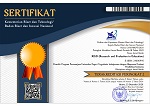Psychometric characteristic of positive affect scale within the academic setting
DOI:
https://doi.org/10.21831/reid.v5i2.25992Keywords:
positive affect scale, validity analysis, academic settingAbstract
This analysis study is one of several stages that must be passed before testing the structural model. This study is initiated due to the limited information related to the measurement of the Positive Affect Scale within the academic settings. The research method used in this study was a quantitative method. It was done in among 724 students of state junior high schools in Sleman, Yogyakarta. The instrument development consisted of guideline arrangement, language feasibility testing, content validation through expert judgments, trials to measure the item discrimination index, item selection based on the item discrimination results, items representation for each indicator, and the construct validity test for the selected items. The testing of the measurement model used the data analysis techniques of Structural Equation Models (SEM) with the assistance of the AMOS program version of 21. The results of the study show that the validity analysis of the Positive Affect Scale within the academic setting was able to produce items that can reveal constructs or latent concepts appropriately.
References
Aiken, L. R. (1985). Three coefficients for analyzing the reliability and validity of ratings. Educational and Psychological Measurement, 45(1), 131–142. https://doi.org/10.1177/0013164485451012
Arbuckle, J. L. (2013). IBM® SPSS® AmosTM 22 user's guide. Chicago, IL: Amos Development Corporation.
Ashby, F. G., Isen, A. M., & Turken, A. U. (1999). A neuropsychological theory of positive affect and its influence on cognition. Psychological Review, 106(3), 529–550. https://doi.org/10.1037/0033-295X.106.3.529
Azwar, S. (2016). Konstruksi tes kemampuan kognitif. Yogyakarta: Pustaka Pelajar.
Byrne, B. M. (2010). Structural Equation Modeling with AMOS: Basic concept, application, and programming (2nd ed.). New York, NY: Routledge Taylor & Francis Group.
Dachlan, U. (2014). Panduan lengkap Struktural Equation Modeling tingkat dasar: Metodologi, konsepsi, aplikasi (dengan Amos) (1st ed.). Semarang: Lentera Ilmu.
Danner, D. D., Snowdon, D. A., & Friesen, W. V. (2001). Positive emotions in early life and longevity: Findings from the nun study. Journal of Personality and Social Psychology, 80(5), 804–813. https://doi.org/10.1037/0022-3514.80.5.804
Demanet, J., Liefooghe, B., & Verbruggen, F. (2011). Valence, arousal, and cognitive control: A voluntary task-switching study. Frontiers in Psychology, 2(336), 1–9. https://doi.org/10.3389/fpsyg.2011.00336
Folkman, S. (2008). The case for positive emotions in the stress process. Anxiety, Stress and Coping, 21(1), 3–14. https://doi.org/10.1080/10615800701740457
Fredrickson, B. L. (1998). What good are positive emotions? Review of General Psychology, 2(3), 300–319. https://doi.org/10.1037/1089-2680.2.3.300
Fredrickson, B. L., & Joiner, T. (2002). Positive emotions trigger upward spirals toward emotional well-being. Psychological Science, 13(2), 172–175. https://doi.org/10.1111/1467-9280.00431
Fredrickson, B. L., Mancuso, R. A., Branigan, C., & Tugade, M. M. (2000). The undoing effect of positive emotions. Motivation and Emotion, 24(4), 237–258. https://doi.org/10.1023/a:1010796329158
Fredrickson, B. L., Tugade, M. M., Waugh, C. E., & Larkin, G. R. (2003). What good are positive emotions in crisis? A prospective study of resilience and emotions following the terrorist attacks on the United States on September 11th, 2001. Journal of Personality and Social Psychology, 84(2), 365–376. https://doi.org/10.1037/0022-3514.84.2.365
Ghozali, I. (2017). Model persamaan struktural Kkonsep dan aplikasi dengan program AMOS 24 Update Bayesian SEM (7th ed.). Semarang: Badan Penerbit Universitas Diponegoro.
Goetz, T., Pekrun, R., Hall, N., & Haag, L. (2006). Academic emotions from a social-cognitive perspective: Antecedents and domain specificity of students' affect in the context of Latin instruction. British Journal of Educational Psychology, 76(2), 289–308. https://doi.org/10.1348/000709905X42860
Hair, G., Black, B., Babin, B., Anderson, R., & Tatham, R. (2010). Multivariate data analysis (7th ed.). Upper Saddle River, NJ: Pearson.
Kline, R. (2011). Principle and practice of Sructural Equation Modeling (3rd ed.). New York, NY: The Guilford Press.
Linnenbrink-Garcia, L., & Pekrun, R. (2011). Students' emotions and academic engagement: Introduction to the special issue. Contemporary Educational Psychology, 36(1), 1–3. https://doi.org/10.1016/j.cedpsych.2010.11.004
Linnenbrink, E. A. (2006). Emotion research in education: Theoretical and methodological perspectives on the integration of affect, motivation, and cognition. Educational Psychology Review, 18(4), 307–314. https://doi.org/10.1007/s10648-006-9028-x
Lyubomirsky, S., King, L., & Diener, E. (2005). The benefits of frequent positive affect: Does happiness lead to success? Psychological Bulletin, 131(6), 803–855. https://doi.org/10.1037/0033-2909.131.6.803
Nath, P., & Pradhan, R. K. (2012). Influence of positive affect on physical health and psychological well-being: Examining the mediating role of psychological resilience. Journal of Health Management, 14(2), 161–174. https://doi.org/10.1177/097206341201400206
Netemeyer, R. G., Bearden, W. O., & Sharma, S. (2003). Scaling procedures: Issues and applications. https://doi.org/10.4135/9781412985772
Pekrun, R. (1992). The impact of emotions on learning and achievement: Towards a theory of cognitive/motivational mediators. Applied Psychology, 41(4), 359–376. https://doi.org/10.1111/j.1464-0597.1992.tb00712.x
Pekrun, R., Goetz, T., Titz, W., & Perry, R. P. (2002). Academic emotions in students' self-regulated learning and achievement: A program of qualitative and quantitative research. Educational Psychologist, 37(2), 91–105. https://doi.org/10.1207/S15326985EP3702_4
Pekrun, R., Goetz, T., Titz, W., Perry, R. P., Pekrun, R., Goetz, T., ... Perry, R. P. (2010). Academic Emotions in Students ' Self-Regulated Learning and Achievement : A Program of Qualitative and Quantitative Research Academic Emotions in Students ' Self-Regulated Learning and Achievement : A Program of Qualitative and Quantitative Research. (October 2014), 37–41. https://doi.org/10.1207/S15326985EP3702
Samios, C., Abel, L. M., & Rodzik, A. K. (2013). The protective role of compassion satisfaction for therapists who work with sexual violence survivors: An application of the broaden-and-build theory of positive emotions. Anxiety, Stress & Coping, 26(6), 610–623. https://doi.org/10.1080/10615806.2013.784278
Schutz, P. A., & Lanehart, S. L. (2002). Introduction: Emotions in education. Educational Psychologist, 37(2), 67–68. https://doi.org/10.1207/S15326985EP3702_1
Seligman, M. E. P., Ernst, R. M., Gillham, J., Reivich, K., & Linkins, M. (2009). Positive education: Positive psychology and classroom interventions. Oxford Review of Education, 35(3), 293–311. https://doi.org/10.1080/03054980902934563
Steptoe, A., Dockray, S., & Wardle, J. (2009). Positive affect and psychobiological processes relevant to health. Journal of Personality, 77(6), 1747–1776. https://doi.org/10.1111/j.1467-6494.2009.00599.x
Watson, D., Clark, L. A., & Tellegen, A. (1988). Development and validation of brief measures of positive and negative affect: The PANAS scales. Journal of Personality and Social Psychology, 54(6), 1063–1070. https://doi.org/10.1037/0022-3514.54.6.1063
Watson, D., & Tellegen, A. (1985). Toward a consensual structure of mood. Psychological Bulletin, 98(2), 219–235. https://doi.org/10.1037/0033-2909.98.2.219
Yik, M., Russell, J. A., & Steiger, J. H. (2011). A 12-point circumplex structure of core affect. Emotion, 11(4), 705–731. https://doi.org/10.1037/a0023980
Downloads
Published
How to Cite
Issue
Section
License
The authors submitting a manuscript to this journal agree that, if accepted for publication, copyright publishing of the submission shall be assigned to REiD (Research and Evaluation in Education). However, even though the journal asks for a copyright transfer, the authors retain (or are granted back) significant scholarly rights.
The copyright transfer agreement form can be downloaded here: [REiD Copyright Transfer Agreement Form]
The copyright form should be signed originally and sent to the Editorial Office through email to reid.ppsuny@uny.ac.id

REiD (Research and Evaluation in Education) by http://journal.uny.ac.id/index.php/reid is licensed under a Creative Commons Attribution-ShareAlike 4.0 International License.






.png)





